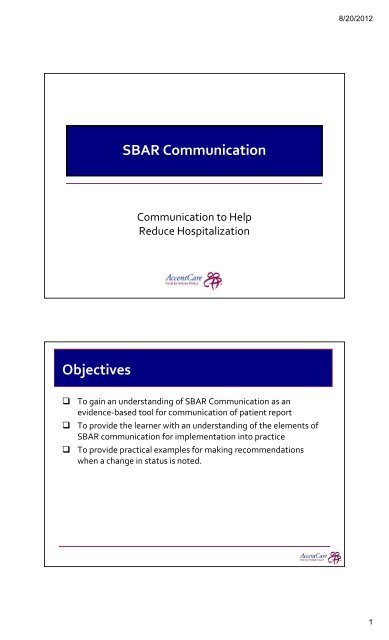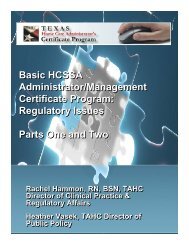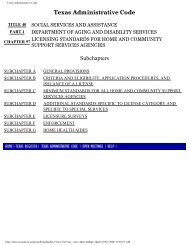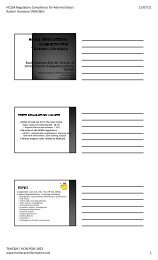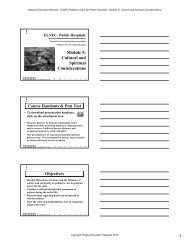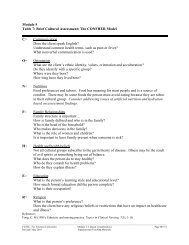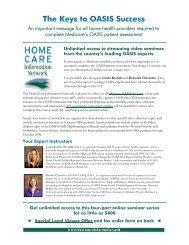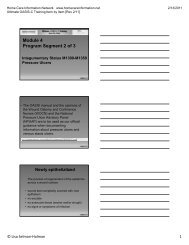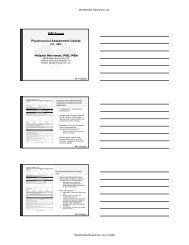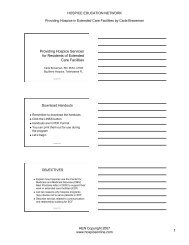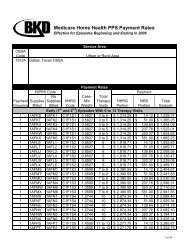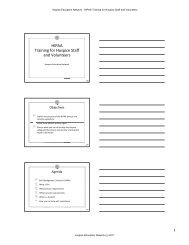SBAR Communication Objectives - Home Care Information Network
SBAR Communication Objectives - Home Care Information Network
SBAR Communication Objectives - Home Care Information Network
- No tags were found...
You also want an ePaper? Increase the reach of your titles
YUMPU automatically turns print PDFs into web optimized ePapers that Google loves.
8/20/2012<br />
<strong>SBAR</strong> <strong>Communication</strong><br />
<strong>Communication</strong> to Help<br />
Reduce Hospitalization<br />
<strong>Objectives</strong><br />
<br />
<br />
<br />
To gain an understanding of <strong>SBAR</strong> <strong>Communication</strong> as an<br />
evidence-based tool for communication of patient report<br />
To provide the learner with an understanding of the elements of<br />
<strong>SBAR</strong> communication for implementation into practice<br />
To provide practical examples for making recommendations<br />
when a change in status is noted.<br />
1
8/20/2012<br />
What is <strong>SBAR</strong> <strong>Communication</strong><br />
<strong>SBAR</strong> is a standardized way of communicating.<br />
<br />
<br />
<br />
<br />
Promotes patient safety because it helps individuals<br />
communicate with each other with a shared set of expectations.<br />
Staff and physicians can use <strong>SBAR</strong> to share patient information in<br />
a concise and structured format.<br />
Improves efficiency, accuracy and patient safety<br />
<strong>SBAR</strong> stands for:<br />
Situation<br />
Background<br />
Assessment<br />
Recommendation<br />
Why use <strong>SBAR</strong> <strong>Communication</strong><br />
<br />
<br />
<strong>SBAR</strong> is a preferred best practice for reporting a patient’s<br />
condition and seeking treatment orders.<br />
<strong>SBAR</strong> communication was proven 1 to be effective in reducing<br />
hospitalizations when the clinician makes an appropriate<br />
recommendation for care.<br />
2
8/20/2012<br />
Where is the Disconnect<br />
We all want what’s best for the<br />
patient<br />
The clinician wants to report an<br />
important issue to the physician so<br />
that the patient needs are met…<br />
The physician wants to make sure the<br />
patient receives appropriate care…<br />
So what could possibly<br />
go wrong<br />
Take This Situation, for Example<br />
<br />
Ms. Jones is a new patient admitted three days ago following a<br />
hospitalization for heart failure exacerbation. She begins to have<br />
the following symptoms:<br />
• Her weight is 3lbs greater than it was yesterday<br />
• She complains of feeling fatigued<br />
• You note rales in her anterior and posterior lower lung fields.<br />
• She has 2+ pitting edema in her ankles, where previously there was none.<br />
• She has taken the medications in her prefilled medication box that was set<br />
up to help ensure her compliance.<br />
<br />
How the nurse reports the situation can effect<br />
how the physician reacts to the situation…<br />
3
8/20/2012<br />
Where is the Disconnect<br />
The Nurse’s Report<br />
Dr. Smith, this is Nurse Jackie from Accent<strong>Care</strong>, calling<br />
about your patient, Ms. Jones .<br />
She was admitted to home health three days ago<br />
following a hospitalization for heart failure exacerbation.<br />
During her assessment today, I noted that she has gained<br />
3 pounds since yesterday and is feeling fatigued. She has<br />
rales in her anterior and posterior lower lung fields and 2+<br />
pitting edema in her ankles, where previously there was<br />
none.<br />
She has taken the medications as prescribed.<br />
What do you want me to do with her<br />
Where is the Disconnect<br />
The Nurse’s Report<br />
<br />
The nurse has given a good report of the<br />
patient’s condition.<br />
<br />
She feels good that she has identified a change<br />
in condition that indicates a need for physician<br />
intervention.<br />
<br />
What is the physician likely to do when<br />
receiving this report<br />
4
8/20/2012<br />
Where is the Disconnect<br />
The Physician’s Reaction<br />
Dr. Smith says “Send Ms. Jones to the Emergency<br />
Department at St. Mary’s for evaluation.”<br />
Why did the physician order this<br />
Remember:The physician wants to make sure the patient<br />
receives appropriate care…<br />
What the physician perceived from the nurse’s report was:<br />
“My patient is in trouble and the home health nurse does<br />
not know what to do. I need to ensure that the patient<br />
receives appropriate care.”<br />
What could the nurse have done differently<br />
Recommendation –<br />
The Missing Piece<br />
<br />
In the example, the nurse gave a report that<br />
included a summary of the:<br />
• Situation, Background and Assessment of the<br />
patient’s condition, but did not make a<br />
Recommendation.<br />
<br />
<br />
What recommendations could be made<br />
How might the recommendation effect the<br />
outcome<br />
5
8/20/2012<br />
Same Report, with Recommendations<br />
Dr. Smith, this is Nurse Jackie from Accent<strong>Care</strong>, calling about your patient, Ms. Jones.<br />
She was admitted to home health three days ago following a hospitalization for heart<br />
failure exacerbation.<br />
During her assessment today, I noted she has gained 3 pounds since yesterday and is<br />
feeling fatigued. She has rales in her anterior and posterior lower lung fields and 2+<br />
pitting edema in her ankles, where previously there was none.<br />
She has taken the medications as prescribed.<br />
Would you like to increase her diuretic therapy I can assess her response tomorrow<br />
and collect any labs that you may want. What would you like to order<br />
How might the physician respond differently given this report<br />
Could This Make a Difference<br />
The Physician’s Response<br />
Dr. Smith says “That sounds like a good idea. Lets increase<br />
her HCTZ to 50mg for the next 3 days and please draw a<br />
potassium level on the third day. Keep an eye on her for the<br />
next few days and get me the results. We can decide if that is<br />
a good dose to continue.”<br />
Remember: The physician wants to make sure the patient<br />
receives appropriate care…<br />
So what was the difference this time<br />
What the physician perceived from the nurse’s report was<br />
this:<br />
“My patient is in trouble and the home health nurse has<br />
given a good report and a feasible option on how to help<br />
the patient.”<br />
6
8/20/2012<br />
<strong>SBAR</strong> Works<br />
The evidence in favor of <strong>SBAR</strong> communication is well documented:<br />
<br />
<br />
<br />
STAR Quality Initiative demonstrated that the use of this in home<br />
health helps reduce avoidable emergent care and<br />
hospitalizations 1<br />
Hospital systems use <strong>SBAR</strong> as part of their core initiatives for<br />
Patient Safety 2<br />
The Joint Commission endorses use of <strong>SBAR</strong> in care handoffs and<br />
physician report 3<br />
Prepare Before You Call<br />
The clinician must gather all of the information needed to give the<br />
<strong>SBAR</strong> report effectively. Prior to calling the physician, follow these<br />
steps:<br />
<br />
<br />
<br />
<br />
<br />
<br />
Have I seen and assessed the patient myself before calling<br />
Has the situation been discussed with a clinical supervisor<br />
Review the chart for appropriate physician to call.<br />
Do I know the report from nurse who worked with the patient<br />
ahead of me<br />
Have available the following when speaking with the physician:<br />
• List of current medications, allergies, and any pertinent labs<br />
• Most recent vital signs<br />
• Reporting vitals/labs: provide the date of previous tests for comparison.<br />
Review the problem and potential recommendations.<br />
7
8/20/2012<br />
When You Call, Use the <strong>SBAR</strong> Method<br />
(S) Situation: What is the situation you are calling about<br />
<br />
Identify self, agency, patient.<br />
<br />
Briefly state the problem, what is it, when it happened or started,<br />
and how severe.<br />
When You Call, Use the <strong>SBAR</strong> Method<br />
(B) Background: Pertinent background information related to the<br />
situation could include the following:<br />
<br />
<br />
<br />
<br />
The patient’s diagnoses<br />
List of current medications, allergies, and labs<br />
Most recent vital signs and previous vital signs for comparison<br />
Other clinical information<br />
8
8/20/2012<br />
When You Call, Use the <strong>SBAR</strong> Method<br />
(A) Assessment: What is the nurse’s assessment of the situation<br />
<br />
What could be going on with the patient<br />
<br />
The assessment should help form the recommendation you<br />
make.<br />
When You Call, Use the <strong>SBAR</strong> Method<br />
(R) Recommendation<br />
<br />
What is the clinician’s recommendation, or<br />
<br />
What does he/she want<br />
Examples:<br />
• Patient needs to be seen in office<br />
• Order change<br />
9
8/20/2012<br />
Conclusion<br />
<strong>SBAR</strong> promotes better communication. In most cases nurses and<br />
physicians communicate in very different ways.<br />
<br />
Nurses are taught to report in narrative form, providing all details<br />
known about the patient.<br />
<br />
Physicians are taught to communicate using brief “bullet points”<br />
that provide key information to the listener.<br />
Bridging the gap in communication is essential for patient safety.<br />
<strong>SBAR</strong> is an effective way to communicate among clinicians<br />
References<br />
<br />
<br />
<br />
Burt P., Pabin A. (2006). A quest for quality in home healthcare: a<br />
perspective of work in the 6 and 7SOW into the 8SOW: improving<br />
acute care hospitalization. <strong>Home</strong> Healthcare Nurse, (3), 167-71<br />
<strong>SBAR</strong> Technique for <strong>Communication</strong>: A Situational Briefing<br />
Model retrieved on 8/15/12 from<br />
http://www.ihi.org/knowledge/Pages/Tools/<strong>SBAR</strong>TechniqueforCo<br />
mmunicationASituationalBriefingModel.aspx<br />
Thomas CM, Bertram E, Johnson D. (2009). The <strong>SBAR</strong><br />
communication technique: teaching nursing students<br />
professional communication skills. Nurse Educ. 34(4):176-80.<br />
10


